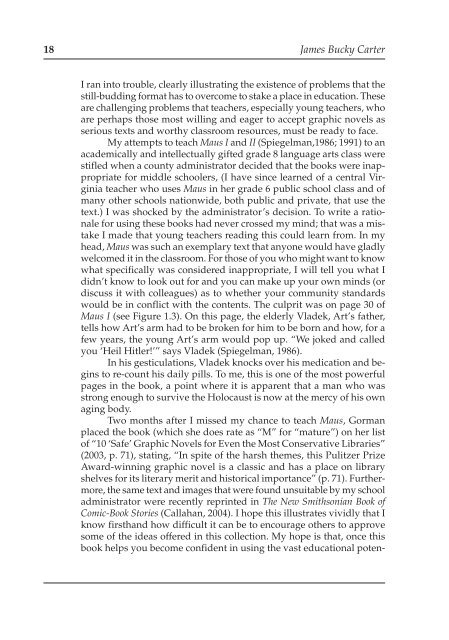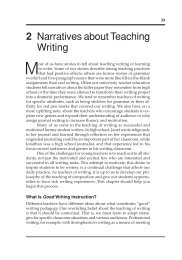Graphic novel Spread - National Council of Teachers of English
Graphic novel Spread - National Council of Teachers of English
Graphic novel Spread - National Council of Teachers of English
- No tags were found...
Create successful ePaper yourself
Turn your PDF publications into a flip-book with our unique Google optimized e-Paper software.
18 James Bucky Carter<br />
I ran into trouble, clearly illustrating the existence <strong>of</strong> problems that the<br />
still-budding format has to overcome to stake a place in education. These<br />
are challenging problems that teachers, especially young teachers, who<br />
are perhaps those most willing and eager to accept graphic <strong>novel</strong>s as<br />
serious texts and worthy classroom resources, must be ready to face.<br />
My attempts to teach Maus I and II (Spiegelman,1986; 1991) to an<br />
academically and intellectually gifted grade 8 language arts class were<br />
stifled when a county administrator decided that the books were inappropriate<br />
for middle schoolers, (I have since learned <strong>of</strong> a central Virginia<br />
teacher who uses Maus in her grade 6 public school class and <strong>of</strong><br />
many other schools nationwide, both public and private, that use the<br />
text.) I was shocked by the administrator’s decision. To write a rationale<br />
for using these books had never crossed my mind; that was a mistake<br />
I made that young teachers reading this could learn from. In my<br />
head, Maus was such an exemplary text that anyone would have gladly<br />
welcomed it in the classroom. For those <strong>of</strong> you who might want to know<br />
what specifically was considered inappropriate, I will tell you what I<br />
didn’t know to look out for and you can make up your own minds (or<br />
discuss it with colleagues) as to whether your community standards<br />
would be in conflict with the contents. The culprit was on page 30 <strong>of</strong><br />
Maus I (see Figure 1.3). On this page, the elderly Vladek, Art’s father,<br />
tells how Art’s arm had to be broken for him to be born and how, for a<br />
few years, the young Art’s arm would pop up. “We joked and called<br />
you ‘Heil Hitler!’” says Vladek (Spiegelman, 1986).<br />
In his gesticulations, Vladek knocks over his medication and begins<br />
to re-count his daily pills. To me, this is one <strong>of</strong> the most powerful<br />
pages in the book, a point where it is apparent that a man who was<br />
strong enough to survive the Holocaust is now at the mercy <strong>of</strong> his own<br />
aging body.<br />
Two months after I missed my chance to teach Maus, Gorman<br />
placed the book (which she does rate as “M” for “mature”) on her list<br />
<strong>of</strong> “10 ‘Safe’ <strong>Graphic</strong> Novels for Even the Most Conservative Libraries”<br />
(2003, p. 71), stating, “In spite <strong>of</strong> the harsh themes, this Pulitzer Prize<br />
Award-winning graphic <strong>novel</strong> is a classic and has a place on library<br />
shelves for its literary merit and historical importance” (p. 71). Furthermore,<br />
the same text and images that were found unsuitable by my school<br />
administrator were recently reprinted in The New Smithsonian Book <strong>of</strong><br />
Comic-Book Stories (Callahan, 2004). I hope this illustrates vividly that I<br />
know firsthand how difficult it can be to encourage others to approve<br />
some <strong>of</strong> the ideas <strong>of</strong>fered in this collection. My hope is that, once this<br />
book helps you become confident in using the vast educational poten-
















